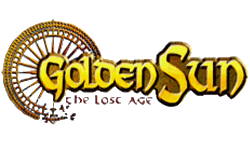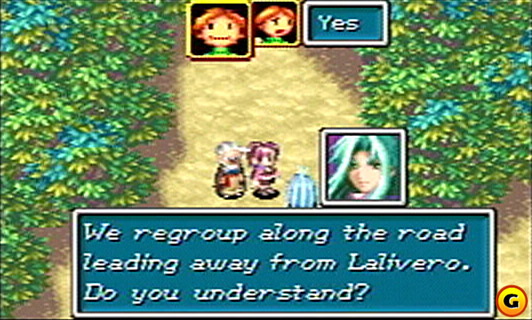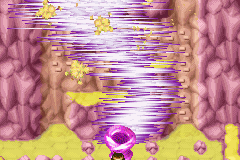|
|

|
PLATFORM
|
GBA
|
BATTLE SYSTEM
|

|
INTERACTION
|

|
ORIGINALITY
|

|
STORY
|

|
MUSIC & SOUND
|

|
VISUALS
|

|
CHALLENGE
|
Moderate
|
COMPLETION TIME
|
20-40 Hours
|
|
OVERALL

|
+ Same as first game.
- Same as first game.
|
Click here for scoring definitions
|
|
|
Golden Sun on the Gameboy Advance was reasonably well-received in Japan and North America, so it was only natural that its developer, Camelot Software Planning, produced a sequel, Golden Sun: The Lost Age, continuing its predecessor's story and inheriting its gameplay and graphics. The sequel also allows players to import data, which includes items and Djinn, from the first game through a long password or a Game Link Cable, and as such, having played the original game first is highly recommended. The second Golden Sun, more or less, bequeaths all the positive and negative aspects of its predecessor.
The Lost Age's game mechanisms are largely identical to those in the first game, with an emphasis on puzzle-solving during dungeon exploration through the use of Psychic Point-consuming abilities. The Djinni system returns, as well, with the player able to collect Djinn in towns and dungeons, or on the overworld, sometimes requiring a fight. The player can "equip" them for higher stats and more abilities or put them on standby for use as summon spells in battle at the expense of lower stats and fewer abilities. New to the sequel is the ability to use summon spells that require Djinn of different elements, acquired through special tablets across the world.
The general structure of combat remains the same as in the first game, with each of the four active characters able to attack, defend, use magic, use items, use a Djinni's ability (which will put it on standby), equip a Djinni, or cast a summon spell with Djinn on standby, which will afterward require the consumed Djinn to recover after a few turns. When the player acquires more than four characters, the ability to swap active characters with inactive characters becomes available, though the player can only swap out one ally per turn, adding some challenge.
 All choices lead to the same end
All choices lead to the same end
|
|
Even so, the sequel isn't too difficult, with normal encounters rarely posing a threat and mostly being quick affairs, and boss encounters being manageable, especially if players remember to set Djinn on standby beforehand and blast them with summon spells the first turn. Item use is also a rarity, with several spells providing healing, some to the whole party, and a few Djinn abilities recovering PP, as well. Overall, the puzzles during exploration are nice diversions, and the combat mechanisms, while easy, are also reasonably solid and have plenty of variety.
The game interface also remains the same as it did in the first Golden Sun, with a generally-easy menu system and an always-convenient save-anywhere feature. However, item management can still be a hassle when each character's individual inventory space is at its capacity, there is still a general poor direction on how to advance the main storyline, and dashing is barely faster than walking. The sequel, though, does eventually provide warp magic to teleport to previously-visited towns, although this doesn't become available until the final dungeon. Ultimately, control in the sequel is neither good nor bad.
It is ludicrous to damn a direct sequel that intentionally reuses its predecessor's gameplay and graphics engines such as The Lost Age for being unoriginal, with the most significant changes being new lands that expand upon the first game's world, new playable characters, and multi-elemental summon spells. In many ways, one could consider the sequel to be an extension of its predecessor, which was in many ways an amalgamation of elements from other RPGs, mainly Camelot's previous titles such as Beyond the Beyond, yet had some mildly inventive elements such as the Djinn system.
 Purple tornado
Purple tornado
|
|
The Lost Age, as mentioned, continues its predecessor's plot, which largely suffers from the same problems that plagued the first game, including conversations that drag out for too long, weak direction of where to go next, little meaningful character development, and both menial tasks and endless yes/no decisions that have little impact on the main storyline. Moreover, a character that was talkative in the first game is now the silent protagonist, and the first game's conflict between heroes and unthreatening villains has been replaced with even less conflict. The ending does give a semblance of closure, but the narrative just doesn't flow very well.
Motoi Sakuraba returns to compose the sequel's soundtrack, which is generally solid and of good quality for a Gameboy Advance game, although the sound effects still remain weak. The sequel also reuses its predecessor's graphics engine, not a bad thing as they're still some of the best on the Gameboy Advance, with vibrant colors and environs, and dynamic battle visuals with nice effects albeit some degree of pixelation. The "shaking" of character sprites outside battle during cutscenes is also somewhat odd. All in all, The Lost Age both looks and sounds nice.
Given the bigger world compared to its predecessor, the sequel is somewhat longer, taking somewhere from twenty to forty hours to finish, with a few sidequests and the backtracking necessary to perform them padding out playing time. All in all, Golden Sun: The Lost Age is a solid sequel that bequeaths all that's bad and good about its predecessor while slightly building upon it. It certainly won't appeal to those that didn't enjoy the first game, but since it's essentially a continuation of the original Golden Sun, those that did indeed like the first game likely won't be disappointed.
Review Archives
|









